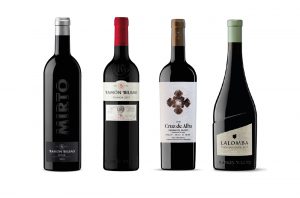It’s impossible to talk about Spanish wine without mentioning the king of Spanish grapes, Tempranillo. Made famous by its use in the ageworthy and iconic reds from Rioja and Ribera del Duero, this variety has much to offer through its various expressions all over Spain and the high quality wines it produces.
Thought to have originated in Rioja, Tempranillo is now the most widely planted red grape in Spain as well as one of the most widely cultivated in the world. The name Tempranillo comes from the Spanish word ‘temprano’, which means ‘early’, because it is an early cycle grape that also has fairly good resistance to many vine diseases.
Tempranillo is a thick-skinned grape that grows in tight clusters. This is sometimes a problem for growers as the bunches can become more susceptible to fungal disease. Vines grow best in clay, limestone and chalky soils. Despite its early cycle, Tempranillo is not a warm-region grape and thrives in the cooler, more Atlantic subregions of Rioja, Rioja Alta and Rioja Alavesa, as well as the high altitudes of Ribera del Duero.
In these areas, the days are warm and sunny which helps with ripeness and the development of the grape’s characteristic red and black fruit flavors. However the nights are cool and windy, which slows down the ripening and allows Tempranillo to maintain a higher level of acidity and freshness.
Tempranillo goes by many other names depending on the region, including Cencibel in Castilla La Mancha, Tinta del País in Ribera del Duero and Ull de Llebre (literally ‘eye of the hare’ in Catalan) in Catalonia. It is also known as Tinto de Toro, Aragonez, Tinto Fino and Tinta Roriz in Portugal where it is used in the production of both Port and still wines.
Styles of Tempranillo
Tempranillo is a well-balanced and versatile grape variety that has medium acidity and is well structured. It produces a variety of wine styles depending on the region of origin and winemaking techniques.
Rioja
Traditionally in Rioja, Tempranillo was blended with a small amount of other local red grapes – such as Garnacha and Mazuelo (Carignan) – and aged for many years in American oak barrels, giving the wine aromas of sweet spices and coconut. In fact, the traditional classification system of Rioja classifies the wines by the amount of time they spend ageing both in barrels and in the bottle.
The wines labeled on the bottle as joven, crianza, reserva and gran reserva signify the amount of ageing the wine has undergone. Joven (meaning ‘young’ in Spanish) are the youngest and gran reserva wines have had the most ageing. The younger wines have flavours of cherry, raspberry, vanilla and coconut; while those with more age offer more complexity, with earthy and savory flavours such as leather, liquorice, tobacco and chocolate.
In addition to the traditional system, which remains important and produces some of the most long-lived and intense reds, there has also been a modern Rioja movement. Instead of blending, some producers are now choosing to make single-varietal Tempranillo wines.
Others have opted for ageing in French oak, which adds more subtle spice and toasty notes, and some have even started experimenting with amphorae and concrete ageing techniques. It’s worth noting that these wines are labelled in the most basic joven category, even though they have been aged for longer than many of the traditional style wines.
Ribera del Duero
In Ribera del Duero it is much more common to find wines made from 100% Tempranillo or in blends with international varieties such as Cabernet Sauvignon and Merlot. Here, the climate and the local clone give much darker fruit flavours than in Rioja: blackberry and black cherry as well as more structure and tannins.
The Tempranillo wines in Ribera del Duero are generally aged in French oak barrels. The combination of tannins, good acidity from the altitude and oak ageing mean that the best of these wines can age for many years, even decades.
Other regions
In Toro, located in Castilla y Léon, Tempranillo wines take on a much more structured and deep black fruit profile. The grape is also found in the regions of Catalonia, Navarra, around Madrid and in Castilla La Mancha.
With food
Tempranillo´s classic savoury aromas such as leather and tobacco leaves make it a perfect match for roast lamb, stews and pastas with tomatoes and mushrooms. Additionally, Tempranillo matches well with charcuterie and other grilled or smoked meats.
Spanish Wine Academy from Ramón Bilbao
A note from our sponsor
Tempranillo wines to try

Cruz de Alba Crianza, Ribera del Duero 2018
A very intense red colour, with a youthful bluish edge. The nose is fragrant, fruity, fresh and intense, with black fruit, balsamic notes and spice integrating with subtle, balanced wood. The palate has ripe tannins and a velvety texture.
Lalomba Finca Valhonta, Rioja 2017
Made from a 2.8ha Tempranillo vineyard in Rioja Alta, Finca Valhonta spends 14 months in 500-litre oak barrels and a further eight months in concrete. Sophisticated, expressive and elegant, with a powerful fruity and floral character. A well-balanced expression of the identity of the vineyard it comes from, showing purity of fruit and the freshness of the terroir.
Ramón Bilbao Crianza, Rioja 2017
A fresh and fruity ruby-red Tempranillo with aromas of black and red fruit, nutshells and floral hints. Ageing in oak casks contributes sweet aromas of nutmeg, vanilla and cinnamon. A medium-bodied palate with a good balance of fruity and spicy notes.
Ramón Bilbao Mirto, Rioja 2015
Deep ruby-red colour with intense, complex aromas of dark fruit and spices (cloves, nutmeg and black pepper), with hints of liquorice, balsamic, smoke, chocolate and coffee beans. The well-balanced and harmonious palate is intense, complex, juicy and long, with ripe tannins.








